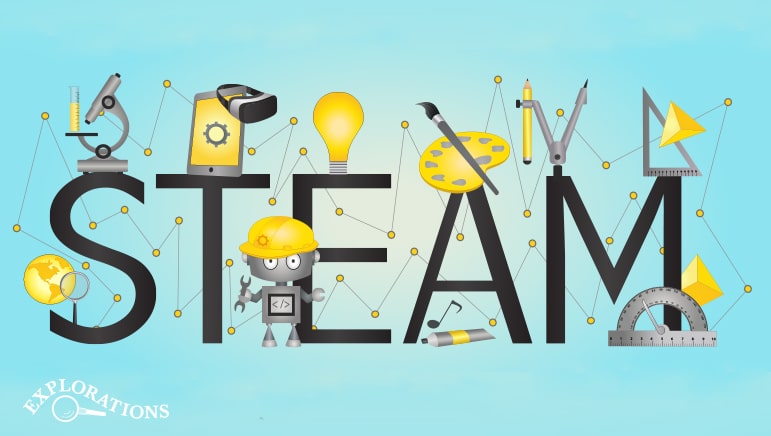For generations of parents and educators, proficiency and even interest in Science or in the Arts were seen to be mutually exclusive. Science was deemed to be rational and analytical (left side of the brain) and the Arts were described as creative, whimsical and expressive (right side of the brain). Until recently, it had been accepted as “common knowledge” that analytical scientists and creative artists were on opposite sides of a spectrum. (Art Institute of Vancouver)
However, more recent research and commentary indicates that Artists and Scientists have much more in common than previously thought. Artists and scientists both have to be creative: they both have to develop original ideas and push frontiers. An un-creative scientist is not going to solve many problems before getting stuck on a problem that requires the integration of many different ideas and creative solutions. (OdysseyOnline)
There is now known to be, in fact, a deep relationship between Science and the Arts – they need each other. Both types of intelligence should be fostered in our children equally and we need to integrate where Science and Art collide. Exposure to both Science and the Visual Arts offers children the latitude to think, discover, and make connections with an empathetic disposition (Alberts, 2011).
The Da Vinci Genome initiative – “How Science Drives Art and Art Drives Science”. **** further challenges the supposition that analytical scientists and creative artists are on opposite sides of a spectrum. But are they so different? Artists and scientists both have to be creative: they both have to develop original ideas and push frontiers. The “Leonardo Project” continues to explore the interface between scientific research and artistic expression.
At Michigan State University, Kittie Butcher, Robert Root-Bernstein and Michele Root have furthered this inquiry. As a result of their research into the links between the two disciplines, they believe that Art experiences help children develop skills used in science, technology, engineering and math.
In the last several years, educators have been charged with preparing children for the current and future job market. The focus has been well-paying jobs related to fields, otherwise referred to in the acronym STEM (Science, Technology, Engineering and Math). As a result, greater emphasis has been given to Science, Math and Technology, perhaps to the detriment (and resourcing) of the arts. Some educators have struggled with this narrow focus, lamenting the implied depreciation of Arts education and opportunities for children to practice creative skills.
However, research is now supporting the need for enhanced Arts education. As such, The acronym STEM has been rebranded STEAM, with the insertion of the “A” referring to the Arts.
In their jointly- authored book, “Sparks of Genius: The Thirteen Thinking Tools of the World’s Most Creative People,” Michigan State University professors Robert Root-Bernstein and Michele Root-Bernstein highlight several strategies that all creative people use to problem-solve and innovate. A careful review of these “tools” reveals they can all be practiced during art activities.
For example, the Root-Bernstein’s talk about “imagining” as one of the tools all creative people use. “Through visualization, we create mental images that can be translated into other mediums—words, music, movements, models, paintings, diagrams, films, sculptures or mathematical treatises.” Art activities support mathematical thinking by providing an opportunity to develop the skill of imagining. Mathematical and scientific skills are part of the cognitive domain of development (imagining).
The Root-Bernstein’s are among the increasing number of researchers, scientists and educators who have found that grounding in the STEM disciplines is not enough if we want to prepare our children to face a complex world.
In an interview on YouTube, the Root-Bernstein’s make a case that links the arts and sciences. Put simply, “Art + Science = Innovation.” Isn’t innovation one of the major goals of education?
If you would like to explore more information about the benefits of art experiences as they support the study of Science, please refer to the following book and websites as listed on the University of Michigan website:
- Sparks of Genius: The Thirteen Thinking Tools of the World’s Most Creative People, by Robert and Michele Root-Bernstein
- Art + Science = Innovation, YouTube video by Robert and Michele Root-Bernstein
- The Importance of Art in Child Development, PBS Parents
- The Value of Art for the Preschool Child, Education.com
- Benefits of Arts to Kids, Raise Smart Kid
- How Process Art Experiences Support Preschoolers, National Association for the Education of Young Children
- Art – An opportunity to develop children’s skills, Pennsylvania State Extension
Since the founding of Explorations in 1982, the inter-connected relationship between Art and Science activities has always been assumed.
Now that educators and society are acknowledging the important relationship between the Arts and Science, and now that STEM has become STEAM, we invite our young campers to board our Explorations train of discovery and expression as we embark, “full STEAM ahead” into a well-rounded future.


